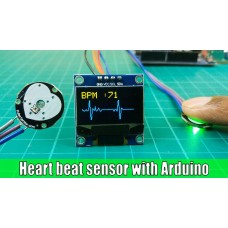Project Description:
The Heart Rate Monitor with Arduino, OLED Display, and Pulse Sensor is a project that measures a person's heart rate and displays it on an OLED display. The project uses a pulse sensor to detect the heart rate of a person. The sensor output is read by an Arduino microcontroller, which processes the data and displays the heart rate on the OLED display.
Working Method:
The pulse sensor is attached to a person's finger or earlobe, and it measures the pulse rate using photoplethysmography (PPG) technology. The sensor output is an analog signal that corresponds to the heart rate. The signal is amplified and filtered using an analog signal conditioning circuit, and then it is connected to an Arduino microcontroller. The Arduino reads the analog signal using the built-in analog-to-digital converter and calculates the heart rate using an algorithm. The heart rate is then displayed on an OLED display.
To set up the project, you will need to connect the pulse sensor to the Arduino and the OLED display. You will also need to program the Arduino to read the pulse sensor data, process it, and display it on the OLED display. The programming can be done in the Arduino IDE using the pulse sensor library and the Adafruit SSD1306 library for the OLED display.
Overall, this project provides a simple and cost-effective way to measure heart rate using an Arduino and pulse sensor and display it on an OLED display. It can be used in medical applications or fitness devices to monitor heart rate and provide basic health information with a compact and portable display.
Heart Rate Monitor with OLED Display
- Product Code: Heart Rate Monitor with OLED Display
- Availability: In Stock
-
₹0.00
.png)
